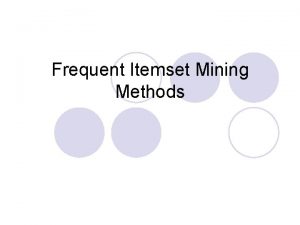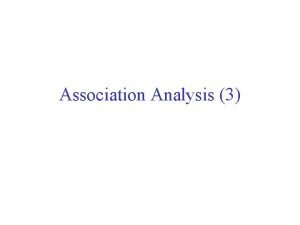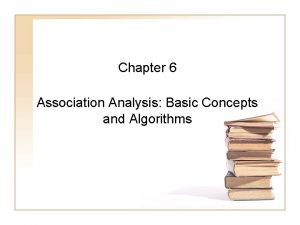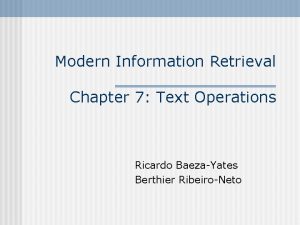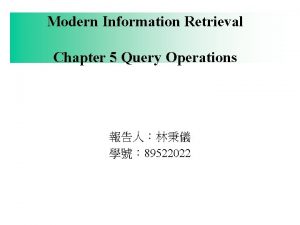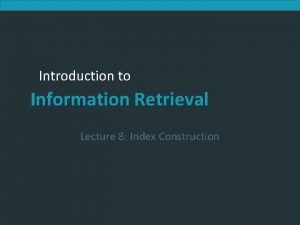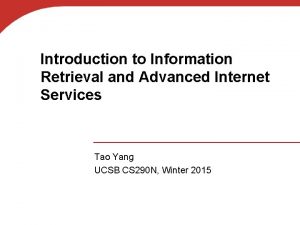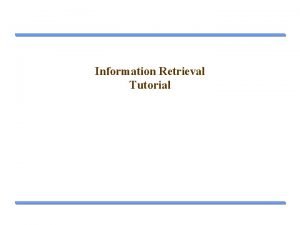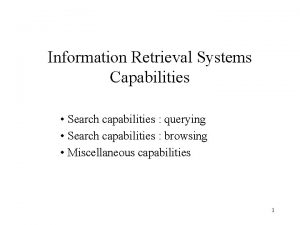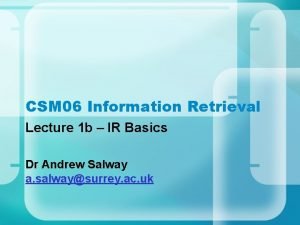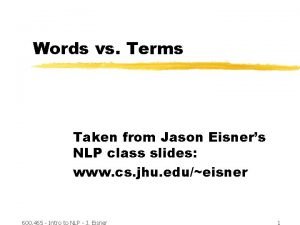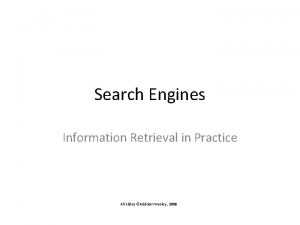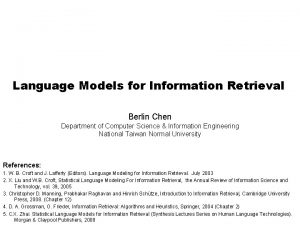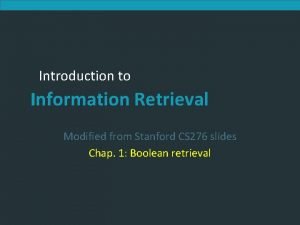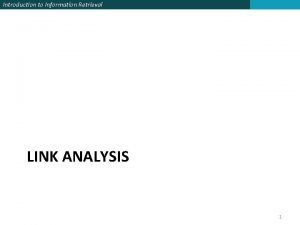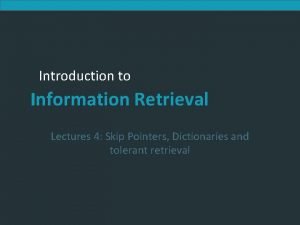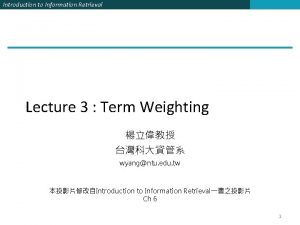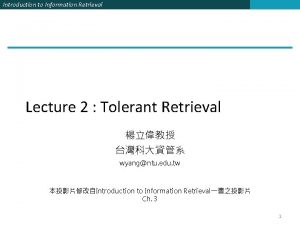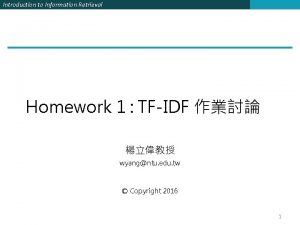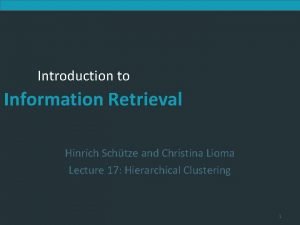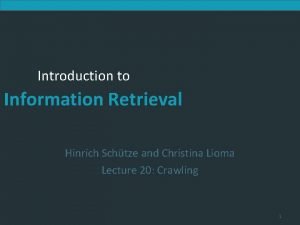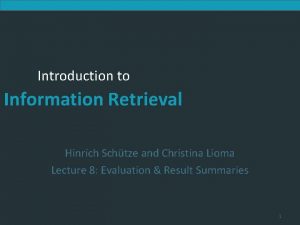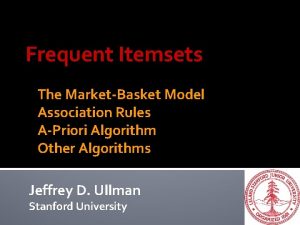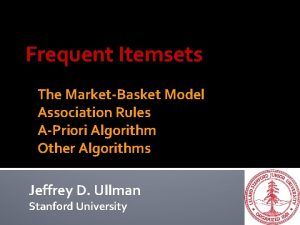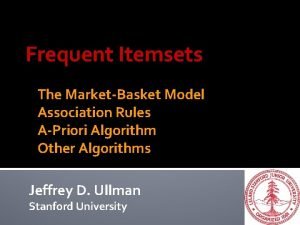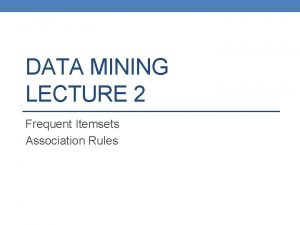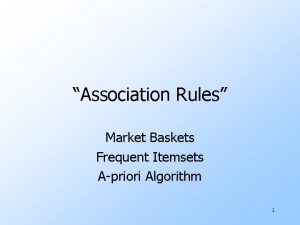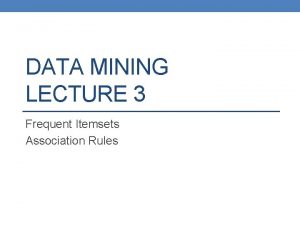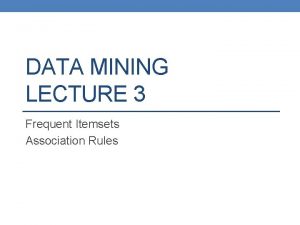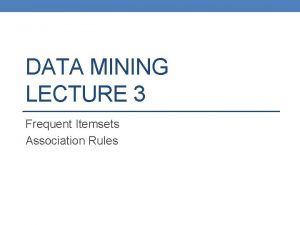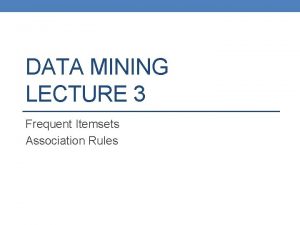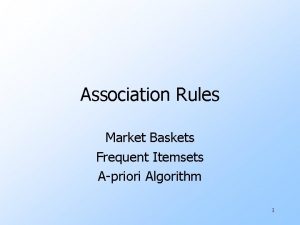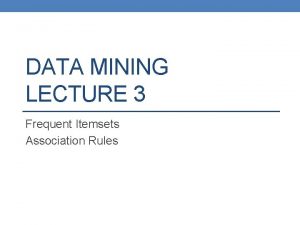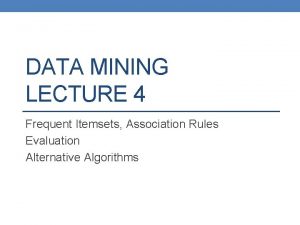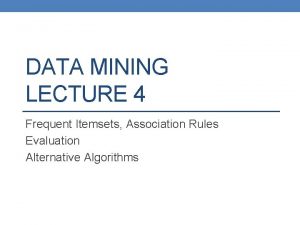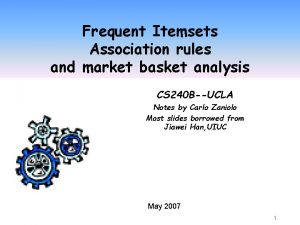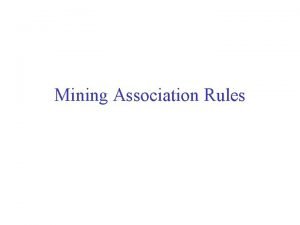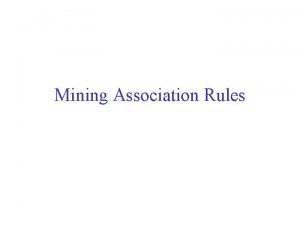Chapter VII Frequent Itemsets Association Rules Information Retrieval












![CHARM Algorithm (I) for Mining Closed Frequent Itemsets [Zaki, Hsiao: SIAM’ 02] Basic Properties CHARM Algorithm (I) for Mining Closed Frequent Itemsets [Zaki, Hsiao: SIAM’ 02] Basic Properties](https://slidetodoc.com/presentation_image_h/e6d98d38a0878d32d87f55ebdde0053b/image-13.jpg)
![CHARM Algorithm (II) for Mining Closed Frequent Itemsets [Zaki, Hsiao: SIAM’ 02] {} Items: CHARM Algorithm (II) for Mining Closed Frequent Itemsets [Zaki, Hsiao: SIAM’ 02] {} Items:](https://slidetodoc.com/presentation_image_h/e6d98d38a0878d32d87f55ebdde0053b/image-14.jpg)























- Slides: 37

Chapter VII: Frequent Itemsets & Association Rules Information Retrieval & Data Mining Universität des Saarlandes, Saarbrücken Winter Semester 2011/12

Chapter VII: Frequent Itemsets & Association Rules VII. 1 Definitions Transaction data, frequent itemsets, closed and maximal itemsets, association rules VII. 2 The Apriori Algorithm Monotonicity and candidate pruning, mining closed and maximal itemsets VII. 3 Mininig Association Rules Apriori, hash-based counting & extensions VII. 4 Other measures for Association Rules Properties of measures Following Chapter 6 of Mohammed J. Zaki, Wagner Meira Jr. : Fundamentals of Data Mining Algorithms. IR&DM, WS'11/12 December 22, 2011 VI. 2

VII. 2 Apriori Algorithm for Mining Frequent Itemsets Lattice of items IR&DM, WS'11/12 December 22, 2011 VI. 3

A Naïve Algorithm For Frequent Itemsets • Generate all possible itemsets (lattice of itemsets): Start with 1 -itemsets, 2 -itemsets, . . . , d-itemsets. • Compute the frequency of each itemset from the data: Count in how many transactions each itemset occurs. • If the support of an itemset is above minsupp then report it as a frequent itemset. Runtime: - Match every candidate against each transaction. - For M candidates and N=|D| transactions, the complexity is: O(N M) => this is very expensive since M = 2|I| IR&DM, WS'11/12 December 22, 2011 VI. 4

Speeding Up the Naïve Algorithm • Reduce the number of candidates (M): – Complete search: M=2|I| – Use pruning techniques to reduce M. • Reduce the number of transactions (N): – Reduce size of N as the size of itemset increases. – Use vertical-partitioning of the data to apply the mining algorithms. • Reduce the number of comparisons (N*M) – Use efficient data structures to store the candidates or transactions. – No need to match every candidate against every transaction. IR&DM, WS'11/12 December 22, 2011 VI. 5

Reducing the Number of Candidates • Apriori principle (main observation): – If an itemset is frequent, then all of its subsets must also be frequent. • Anti-monotonicity property (of support): – The support of an itemset never exceeds the support of any of its subsets. IR&DM, WS'11/12 December 22, 2011 VI. 6

Apriori Algorithm: Idea and Outline: • Proceed in phases i=1, 2, . . . , each making a single pass over D, and generate item set X with |X|=i in phase i; • Use phase i-1 results to limit work in phase i: Anti-monotonicity property (downward closedness): For i-item-set X to be frequent, each subset X’ X with |X’|=i-1 must be frequent, too; Worst-case time complexity still is exponential in |I| and linear in |D|*|I|, but usual behavior is linear in N=|D|. (detailed average-case analysis is strongly data dependent, thus difficult) IR&DM, WS'11/12 December 22, 2011 VI. 7

Apriori Algorithm: Pseudocode procedure apriori (D, min-support): L 1 = frequent 1 -itemsets(D); for (k=2; Lk-1 ; k++) { Ck = apriori-gen (Lk-1, min-support); for each t D { // linear scan of D Ct = subsets of t that are in Ck; for each candidate c Ct {c. count++} }; //end for Lk = {c Ck | c. count min-support} }; //end for return L = k Lk; // returns all frequent item sets procedure apriori-gen (Lk-1, min-support): Ck = : for each itemset x 1 Lk-1 { for each itemset x 2 Lk-1 { if x 1 and x 2 have k-2 items in common and differ in 1 item { // join x = x 1 x 2; if there is a subset s x with s Lk-1 {disregard x} // infreq. subset else {add x to Ck} } } }; return Ck; IR&DM, WS'11/12 December 22, 2011 VI. 8

Illustration For Pruning Infrequent Itemsets Lattice of items Suppose {AB}, {E} are infrequent. Pruned items IR&DM, WS'11/12 December 22, 2011 VI. 9

Using Just One Pass over the Data Idea: Do not use the database for counting support after the 1 st pass anymore! Instead, use data structure Ck’ for counting support in every step: • Ck’ = {<TID, {Xk}> | Xk is a potentially frequent k-itemset in transaction with id=TID} • C 1’: corresponds to the original database • The member Ck’ corresponding to transaction t is defined as <t. TID, {c Ck | c is contained in t}> IR&DM, WS'11/12 December 22, 2011 VI. 10

Apriori. TID Algorithm: Pseudo. Code procedure apriori (D, min-support): L 1 = frequent 1 -itemsets(D); C 1’ = D; for (k=2; Lk-1 ; k++) { Ck = apriori-gen (Lk-1, min-support); Ck’ = for each t Ck-1’ { // linear scan of Ck-1’ instead of D Ct = {c Ck | t[c – c[k]]=1 and t[c – c[k-1]]=1}; for each candidate c Ct {c. count++}; if (Ct ≠ ) {Ck’ = Ck’ Ct}; }; // end for Lk = {c Ck | c. count min-support} }; // end for return L = k Lk; // returns all frequent item sets procedure apriori-gen (Lk-1, min-support): … // as before IR&DM, WS'11/12 December 22, 2011 VI. 11

Mining Maximal and Closed Frequent Itemsets with Apriori Naïve Algorithm: (Bottum-Up Approach) 1) Compute all frequent itemsets using Apriori. 2) Compute all closed itemsets by checking all subsets of frequent itemsets found in 1). 3) Compute all maximal itemsets by checking all subsets of closed and frequent itemsets found in 2). IR&DM, WS'11/12 December 22, 2011 VI. 12
![CHARM Algorithm I for Mining Closed Frequent Itemsets Zaki Hsiao SIAM 02 Basic Properties CHARM Algorithm (I) for Mining Closed Frequent Itemsets [Zaki, Hsiao: SIAM’ 02] Basic Properties](https://slidetodoc.com/presentation_image_h/e6d98d38a0878d32d87f55ebdde0053b/image-13.jpg)
CHARM Algorithm (I) for Mining Closed Frequent Itemsets [Zaki, Hsiao: SIAM’ 02] Basic Properties of Itemset-TID-Pairs: Let t(X) denote the transaction ids associated with X. Let X 1 ≤ X 2 (for under any suitable order function, e. g. , lexical order). 1) If t(X 1) = t(X 2), then t(X 1 X 2) = t(X 1) t(X 2) = t(X 1) = t(X 2). → Replace X 1 with X 1 X 2, remove X 2 from further consideration. 2) If t(X 1) t(X 2), then t(X 1 X 2) = t(X 1) t(X 2) = t(X 1) ≠ t(X 2). → Replace X 1 with X 1 X 2. Keep X 2, as it leads to a different closure. 3) If t(X 1) t(X 2), then t(X 1 X 2) = t(X 1) t(X 2) = t(X 2) ≠ t(X 1). → Replace X 2 with X 1 X 2. Keep X 1, as it leads to a different closure. 4) Else if t(X 1) ≠ t(X 2), then t(X 1 X 2) = t(X 1) t(X 2) ≠ t(X 1). → Do not replace any itemsets. Both X 1 and X 2 lead to different closures. IR&DM, WS'11/12 December 22, 2011 VI. 13
![CHARM Algorithm II for Mining Closed Frequent Itemsets Zaki Hsiao SIAM 02 Items CHARM Algorithm (II) for Mining Closed Frequent Itemsets [Zaki, Hsiao: SIAM’ 02] {} Items:](https://slidetodoc.com/presentation_image_h/e6d98d38a0878d32d87f55ebdde0053b/image-14.jpg)
CHARM Algorithm (II) for Mining Closed Frequent Itemsets [Zaki, Hsiao: SIAM’ 02] {} Items: A C D T W Transactions 1 ACTW 2 CDW 3 ACTW 4 ACDW 5 ACDTW 6 CDT Support 100% 84% 67% 50% A x 1345 C x 123456 AC x 1345 ACW x 1345 ACD x 45 ACT x 135 ACTW x 135 Frequent Itemsets C W, CW A, D, T, AC, AW, CD, CT, ACW AT, DW, TW, ACT, ATW, CDW, CTW, ACTW IR&DM, WS'11/12 D x 2456 T x 1356 CD x 2456 CDT x 56 W x 12345 CT x 1356 CW x 12345 CDW x 245 CTW x 245 Done in 10 steps, found 7 closed & frequent itemsets! December 22, 2011 VI. 14

VII. 3 Mining Association Rules Given: • A set of items I = {x 1, . . . , xm} • A set (bag) D={t 1, . . . , tn} of itemsets (transactions) ti = {xi 1, . . . , xik} I Wanted: Association rules of the form X Y with X I and Y I such that • X is sufficiently often a subset of the itemsets ti, and • when X ti then most frequently Y ti holds as well. support (X Y) = absolute frequency of itemsets that contain X and Y frequency (X Y) = support(X Y) / |D| = P[XY] relative frequency of itemsets that contain X and Y confidence (X Y) = P[Y|X] = relative frequency of itemsets that contain Y provided they contain X Support is usually chosen to be low (in the range of 0. 1% to 1% frequency), confidence (aka. strength) in the range of 90% or higher. IR&DM, WS'11/12 December 22, 2011 VI. 15

Association Rules: Example Market basket data (“sales transactions”): t 1 = {Bread, Coffee, Wine} t 2 = {Coffee, Milk} t 3 = {Coffee, Jelly} t 4 = {Bread, Coffee, Milk} t 5 = {Bread, Jelly} t 6 = {Coffee, Jelly} t 7 = {Bread, Jelly} t 8 = {Bread, Coffee, Jelly, Wine} t 9 = {Bread, Coffee, Jelly} frequency (Bread Jelly) = 4/9 frequency (Coffee Milk) = 2/9 frequency (Bread, Coffee Jelly) = 2/9 confidence (Bread Jelly) = 4/6 confidence (Coffee Milk) = 2/7 confidence (Bread, Coffee Jelly) = 2/4 Other applications: • book/CD/DVD purchases or rentals • Web-page clicks and other online usage etc. IR&DM, WS'11/12 December 22, 2011 VI. 16

Mining Association Rules with Apriori Given a frequent itemset X, find all non-empty subsets Y X such that Y → X – Y satisfies the minimum confidence requirement. • If {A, B, C, D} is a frequent itemset, candidate rules are: ABC → D, ABD → C, ACD → B, BCD → A, A → BCD, B → ACD, C → ABD, D → ABC, AB → CD, AC → BD, AD → BC, BC → AD, BD → AC, CD → AB • If |X| = k, then there are 2 k– 2 candidate association rules (ignoring L → and → L). IR&DM, WS'11/12 December 22, 2011 VI. 17

Mining Association Rules with Apriori How to efficiently generate rules from frequent itemsets? • In general, confidence does not have an anti-monotone property. conf(ABC → D) can be larger or smaller than conf(AB → D) • But confidence of rules generated from the same itemset has an anti-monotone property! • Example: X = {A, B, C, D}: conf(ABC → D) ≥ conf(AB → CD) ≥ conf(A → BCD) Why? → Confidence is anti-monotone w. r. t. number of items on the RHS of the rule! IR&DM, WS'11/12 December 22, 2011 VI. 18

Apriori Algorithm For Association Rules Outline: • Proceed in phases i=1, 2, . . . , each making a single pass over D, and generate rules X Y with frequent item set X (sufficient support) and |X|=i in phase i; • Use phase i-1 results to limit work in phase i: Anti-monotonicity property (downward closedness): For i-item-set X to be frequent, each subset X’ X with |X’|=i-1 must be frequent, too; • Generate rules from frequent item sets; • Test confidence of rules in final pass over D; IR&DM, WS'11/12 December 22, 2011 VI. 19

Illustration for Association Rule Mining IR&DM, WS'11/12 December 22, 2011 VI. 20

Algorithmic Extensions and Improvements • Hash-based counting (computed during very first pass): map k-itemset candidates (e. g. , for k=2) into hash table and maintain one count per cell; drop candidates with low count early. • Remove transactions that don’t contain frequent k-itemset for phases k+1, . . . • Partition transactions D: An itemset is frequent only if it is frequent in at least one partition. • Exploit parallelism for scanning D. • Randomized (approximative) algorithms: Find all frequent itemsets with high probability (using hashing, etc. ). • Sampling on a randomly chosen subset of D, then correct sample. . Mostly concerned about reducing disk I/O cost (for TByte databases of large wholesalers or phone companies). IR&DM, WS'11/12 December 22, 2011 VI. 21

Hash-based Counting of Itemsets • During the main loop of Apriori, the support of candidate itemsets is calculated by matching each candidate against each transaction. • This step can be accelerated by matching a candidate only against transactions that are relevant for this candidate (i. e. , the ones that are contained in the same bucket). IR&DM, WS'11/12 December 22, 2011 VI. 22

Hash-Tree Index for Itemsets Hash-tree for 3 -itemsets: • Build hash-tree index by splitting candidate itemsets according to H • Stop splitting into subsets if current split contains only one element • Inner nodes denote same hash-function H(p) = p mod 3 • Leaf nodes contain all candidate 3 -itemsets 1, 4, 7 Transaction H 12356 3, 6, 9 2, 5, 8 1, 4, 7 145 1, 4, 7 124 457 IR&DM, WS'11/12 H 3, 6, 9 2, 5, 8 H 136 3, 6, 9 2, 5, 8 125 458 159 234 567 1, 4, 7 345 H 2, 5, 8 3, 6, 9 356 357 689 367 368 • Lookup a transaction by iteratively matching its items against H • Check for containment if a leaf is reached December 22, 2011 VI. 23

Extensions and Generalizations of Association Rules • Quantified rules: consider quantitative attributes of item in transactions (e. g. , wine between $20 and $50 cigars, or age between 30 and 50 married, etc. ) • Constrained rules: consider constraints other than count thresholds, (e. g. , count itemsets only if average or variance of price exceeds. . . ) • Generalized aggregation rules: rules referring to aggr. functions other than count (e. g. , sum(X. price) avg(Y. age)) • Multilevel association rules: considering item classes (e. g. , chips, peanuts, bretzels, etc. , belonging to class “snacks”) • Sequential patterns (e. g. , customers who purchase books in some order): combine frequent sequences x 1 x 2 … xn and x 2 … xn xn+1 into frequent-sequence candidate x 1 x 2 … xn xn+1 • From strong rules to interesting rules: consider also lift (aka. interest) of rule X Y: P[XY] / P[X]P[Y] • Correlation rules (see next slides) IR&DM, WS'11/12 December 22, 2011 VI. 24

VII. 4 Other Measures For Association Rule Mining Limitations of support and confidence: (a) Many interesting items might fall below minsupp threshold! (b) Confidence ignores the support of the itemset in the consequent! Consider contingency table (assume n=100 transactions): T T C 20 70 90 C 5 5 10 25 75 100 Consider the rule: tea coffee → support(tea coffee) = 20 → confidence(tea coffee) = 0. 8 But support of coffee alone is 90, and of tea alone it is 25. That is, drinking coffee makes you less likely to drink tea, and drinking tea makes you less likely to drink coffee! Tea and coffee have negative correlation! IR&DM, WS'11/12 December 22, 2011 VI. 25

Correlation Rules Example for strong, but misleading association rule: tea coffee with confidence 80% and support 20 But support of coffee alone is 90, and of tea alone it is 25 tea and coffee have negative correlation! Consider contingency table (assume n=100 transactions): T T C 20 70 90 C 5 5 10 25 75 100 {T, C} is a frequent and correlated item set Correlation rules are monotone (upward closed): If the set X is correlated then every superset X’ X is correlated, too. IR&DM, WS'11/12 December 22, 2011 VI. 26

Correlation Rules Example for strong, but misleading association rule: tea coffee with confidence 80% and support 20 But support of coffee alone is 90, and of tea alone it is 25 tea and coffee have negative correlation! Consider contingency table (assume n=100 transactions): T T C 20 70 90 C 5 5 10 25 75 100 IR&DM, WS'11/12 E[C]=0. 9 E[T]=0. 25 E[(T-E[T])2]=1/4 * 9/16 +3/4 * 1/16= 3/16=Var(T) E[(C-E[C])2]=9/10 * 1/100 +1/10 * 1/100 = 9/100=Var(C) E[(T-E[T])(C-E[C])]= 2/10 * 3/4 * 1/10 – 7/10 * 1/4 * 1/10 – 5/100 * 3/4 * 9/10 + 5/100 * 1/4 * 9/10 = 60/4000 – 70/4000 – 135/4000 + 45/4000 = – 1/40 = Cov(C, T) = – 1/40 * 4/sqrt(3) * 10/3 -1/(3*sqrt(3)) – 0. 2 December 22, 2011 VI. 27

Correlated Item Set Algorithm procedure corrset (D, min-support, support-fraction, significance-level): for each x I compute count O(x); initialize candidates : = ; significant : = ; for each item pair x, y I with O(x) > min-support and O(y) > min-support { add (x, y) to candidates}; while (candidates ) { notsignificant : = ; for each itemset x candidates { construct contingency table T; if (percentage of cells in T with count > min-support is at least support-fraction) { // otherwise too few data for chi-square if (chi-square value for T significance-level) {add X to significant} else {add X to notsignificant} } }; // if/for candidates : = itemsets with cardinality k such that every subset of cardinality k-1 is in notsignificant; // only interested in correlated itemsets of min. cardinality }; //while return significant; IR&DM, WS'11/12 December 22, 2011 VI. 28

Examples of Contingency Tables General form: (for pair of variables A, B) B B A f 11 f 10 f 1+ A f 01 f 00 f 0+ f+1 f+0 N IR&DM, WS'11/12 Examples for binary cont. tables: December 22, 2011 VI. 29

Symmetric Measures for Itemset {A, B} IR&DM, WS'11/12 December 22, 2011 VI. 30

Asymmetric Measures For Rule A B IR&DM, WS'11/12 December 22, 2011 VI. 31

Consistency of Measures Ranking of tables according to symmetric measures Ranking of tables according to asymmetric measures IR&DM, WS'11/12 December 22, 2011 • Rankings may vary substantially! • Many measures provide conflicting information about quality of a pattern. • Want to define generic properties of measures. VI. 32

Properties of Measures Definition (Inversion Property): An objective measure M is invariant under the inversion operation if its value remains the same when exchanging the frequency counts f 11 with f 00 and f 10 with f 01. Definition (Null Addition Property): An objective measure M is invariant under the null addition operation if it is not affected by increasing f 00, while all other frequency counts stay the same. Definition (Scaling Invariance Property): An objective measure M is invariant under the row/column scaling operation if M(T) = M(T’), where T is a contingency table with frequency counts [f 11, f 10, f 01, f 00], T’ is a contingency table with frequency counts [k 1 k 3 f 11, k 2 k 3 f 10, k 1 k 4 f 01, k 2 k 4 f 00], and k 1, k 2, k 3, k 4 Are positive constants. IR&DM, WS'11/12 December 22, 2011 VI. 33

Example: Confidence and the Inversion Property Recall the general form: B B A f 11 f 10 f 1+ A f 01 f 00 f 0+ f+1 f+0 N = f 11/f 1+ = f 11 / f 11+ f 10 ≠ f 00 / f 00 + f 10 = f 00/f+0 (Inversion) confidence(T C) Counter example: T T C 20 70 90 C 5 5 10 25 75 100 IR&DM, WS'11/12 confidence(A B) : = P[B|A] = 20/25 = 0. 8 December 22, 2011 ≠ 5/90 = 0. 055 VI. 34

Simpson’s Paradox (I) Consider the following correlation between people buying an HTDV (H) and an exercise machine (E): E E H 99 81 180 H 54 66 120 153 147 300 confidence(H E) = 99/180 = 0. 55 confidence( H E) = 54/120 = 0. 45 → Customers who buy an HDTV are more likely to buy an exercise machine than those who do not buy an HDTV. IR&DM, WS'11/12 December 22, 2011 VI. 35

Simpson’s Paradox (II) Consider stratified data by including additional variables (data split two groups: college students and working employees): E E Students (44) Employees (256) Total H 1 9 10 confidence(H E) = 1/10 = 0. 10 =: a/b H 4 30 34 confidence( H E) = 4/34 = 0. 12 =: c/d H 98 72 170 confidence(H E) = 98/170 = 0. 57 =: p/q H 50 36 86 confidence( H E) = 50/86 = 0. 58 =: r/s H and E are positively correlated in the combined data but negatively correlated in each of the strata! When pooled together, the confidences of H E and H E are (a+p)/(b+q) and (c+r)/(d+s), respectively. Simpson’s paradox occurs when: (a+p)/(b+q) > (c+r)/(d+s) IR&DM, WS'11/12 December 22, 2011 VI. 36

Summary of Section VII Mining frequent itemset and association rules is a versatile tool for many applications (e-commerce, user recommendations, etc. ). One of the most basic building blocks in data mining for identifying interesting correlations among items/objects based on co-occurrence statistics. Complexity issues mostly due to the huge amount of possible combinations of candidate itemsets (and rules), also expensive when amount of transactions is huge and needs to be read from disk. Apriori builds on anti-monotonicity property of support, whereas confidence does not generally have this property (however pruning is possible to some extent within a given itemset). Many quality measures considered in the literature, each with different properties. Additional Literature: M. J. Zaki and C. Hsiao: CHARM: An efficient algorithm for closed itemset mining. SIAM’ 02. IR&DM, WS'11/12 December 22, 2011 VI. 37
 Apriori algorithm
Apriori algorithm Acebf
Acebf Zscore
Zscore Maximal and closed frequent itemsets
Maximal and closed frequent itemsets Subset operation using hash tree
Subset operation using hash tree Kelvin rodolfo
Kelvin rodolfo Sequential searching in information retrieval
Sequential searching in information retrieval Search engine architecture
Search engine architecture Precision in information retrieval
Precision in information retrieval Text operations in information retrieval
Text operations in information retrieval Query operations in information retrieval
Query operations in information retrieval Positional index information retrieval
Positional index information retrieval Index construction in information retrieval
Index construction in information retrieval Index construction in information retrieval
Index construction in information retrieval Which internet service is used for information retrieval
Which internet service is used for information retrieval Information retrieval tutorial
Information retrieval tutorial Wildcard query in information retrieval
Wildcard query in information retrieval Browse capabilities in information retrieval system
Browse capabilities in information retrieval system Link analysis in information retrieval
Link analysis in information retrieval Information retrieval lmu
Information retrieval lmu Defense acquisition management information retrieval
Defense acquisition management information retrieval Advantages of information retrieval system
Advantages of information retrieval system Information retrieval nlp
Information retrieval nlp Information retrieval data structures and algorithms
Information retrieval data structures and algorithms Information retrieval slides
Information retrieval slides Relevance information retrieval
Relevance information retrieval Stanford information retrieval
Stanford information retrieval Link analysis in information retrieval
Link analysis in information retrieval Which is a good idea for using skip pointers
Which is a good idea for using skip pointers Anthony julius
Anthony julius Levenshtein distance for oslo-snow
Levenshtein distance for oslo-snow Information retrieval
Information retrieval Information retrieval
Information retrieval Relevance information retrieval
Relevance information retrieval Information retrieval
Information retrieval Information retrieval
Information retrieval Information retrieval
Information retrieval Information retrieval
Information retrieval
